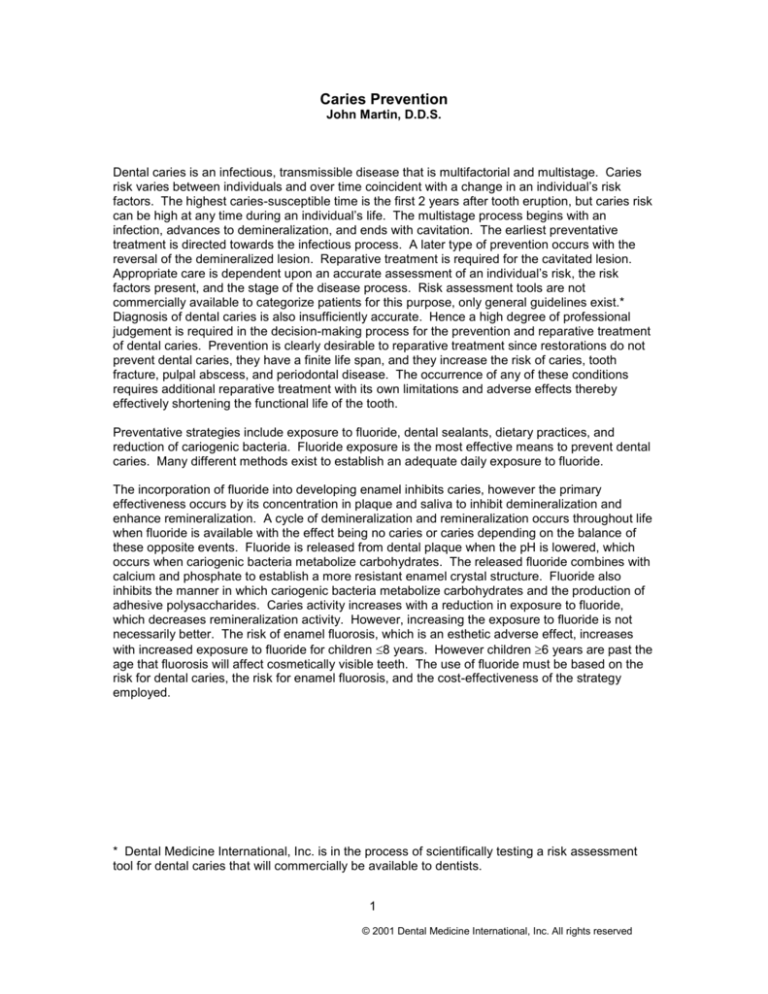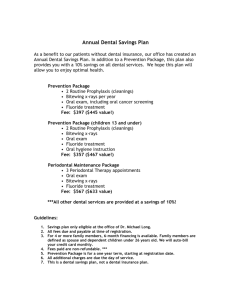
Caries Prevention
John Martin, D.D.S.
Dental caries is an infectious, transmissible disease that is multifactorial and multistage. Caries
risk varies between individuals and over time coincident with a change in an individual’s risk
factors. The highest caries-susceptible time is the first 2 years after tooth eruption, but caries risk
can be high at any time during an individual’s life. The multistage process begins with an
infection, advances to demineralization, and ends with cavitation. The earliest preventative
treatment is directed towards the infectious process. A later type of prevention occurs with the
reversal of the demineralized lesion. Reparative treatment is required for the cavitated lesion.
Appropriate care is dependent upon an accurate assessment of an individual’s risk, the risk
factors present, and the stage of the disease process. Risk assessment tools are not
commercially available to categorize patients for this purpose, only general guidelines exist.*
Diagnosis of dental caries is also insufficiently accurate. Hence a high degree of professional
judgement is required in the decision-making process for the prevention and reparative treatment
of dental caries. Prevention is clearly desirable to reparative treatment since restorations do not
prevent dental caries, they have a finite life span, and they increase the risk of caries, tooth
fracture, pulpal abscess, and periodontal disease. The occurrence of any of these conditions
requires additional reparative treatment with its own limitations and adverse effects thereby
effectively shortening the functional life of the tooth.
Preventative strategies include exposure to fluoride, dental sealants, dietary practices, and
reduction of cariogenic bacteria. Fluoride exposure is the most effective means to prevent dental
caries. Many different methods exist to establish an adequate daily exposure to fluoride.
The incorporation of fluoride into developing enamel inhibits caries, however the primary
effectiveness occurs by its concentration in plaque and saliva to inhibit demineralization and
enhance remineralization. A cycle of demineralization and remineralization occurs throughout life
when fluoride is available with the effect being no caries or caries depending on the balance of
these opposite events. Fluoride is released from dental plaque when the pH is lowered, which
occurs when cariogenic bacteria metabolize carbohydrates. The released fluoride combines with
calcium and phosphate to establish a more resistant enamel crystal structure. Fluoride also
inhibits the manner in which cariogenic bacteria metabolize carbohydrates and the production of
adhesive polysaccharides. Caries activity increases with a reduction in exposure to fluoride,
which decreases remineralization activity. However, increasing the exposure to fluoride is not
necessarily better. The risk of enamel fluorosis, which is an esthetic adverse effect, increases
with increased exposure to fluoride for children 8 years. However children 6 years are past the
age that fluorosis will affect cosmetically visible teeth. The use of fluoride must be based on the
risk for dental caries, the risk for enamel fluorosis, and the cost-effectiveness of the strategy
employed.
* Dental Medicine International, Inc. is in the process of scientifically testing a risk assessment
tool for dental caries that will commercially be available to dentists.
1
© 2001 Dental Medicine International, Inc. All rights reserved
Caries Prevention Recommendations
Basic Preventative Measures for All Populations
Public water supplies should contain the recommended concentration of fluoride. Fluoride
toothpaste should be used twice daily. Children <6 years should use a pea-size amount of
toothpaste. Vigorous rinsing after brushing should be avoided.
Low Risk
No special preventive treatment is required. Reassess risk periodically.
High Caries Risk
Compliance must be taken into account when choosing a preventative strategy.
Supplemental fluoride exposure
Product
Fluoride varnish
5% sodium fluoride
0.1% fluor silane
Fluoride gel or foam office use
1.23% acidulated phosphate fluoride
2% neutral sodium fluoride
Fluoride gel or foam home use
1.1% sodium fluoride
0.4% stannous fluoride
Fluoride mouth rinse
0.2% sodium fluoride
Use
Apply two to four times
annually
By
Professional
Apply twice annually
Use stock tray
Apply for 4 minutes
Apply in custom tray for 4
minutes or brush-on daily
or weekly
Use once or twice daily
Professional
Patient
Patient
Dietary Fluoride supplements
This strategy should be limited to patients between the ages of 6 and 16 and only when the
fluoride concentration in community drinking water is no greater than 0.6 ppm. The tablets
or lozenges should be chewed or sucked for 1-2 minutes before swallowing.
Age
0-6 months
6 months-3 years
3-6 years
6-16 years
Fluoride concentration in community drinking water
<0.3 ppm
0.3-0.6 ppm
None
None
0.25 mg/day
None
0.50 mg/day
0.25 mg/day
1.0 mg/day
0.50 mg/day
Dental Sealants
Apply pit and fissure sealants to all defects at risk. Check periodically.
2
© 2001 Dental Medicine International, Inc. All rights reserved
Dietary Practices
Reduce the frequency of exposure to sugar and other carbohydrates, which occurs with between
meal snacks. Use sugar substitutes like Equal, Sweet and Low, and Xylitol, a sugar alcohol. Use
caries reducing products like Trident Advantage gum and mints and Carefree Koolerz gum.
Reduction of Cariogenic Bacteria
Rinse with Chlorhexidine twice daily for two weeks.
Products
Fluoride Varnish (Professional Use)
Duraphat (1)
Cavity Shield (1)
Duraflor (1)
FluorProtector
(1) 5% Sodium Fluoride
(2) 0.1% Fluor Silane
(ADA) ADA Seal of Acceptance
Colgate
Omni Oral Pharmaceuticals
Medicom (Pharmascience)
Ivoclar-Vivadent
Fluoride Gel or Foam (Professional Use)
Perfect Choice Gel and Foam (1) gel (2)
FluoroCare Gel (2)
Acclean Foam (1) Gel (1) (2)
Protect Gel (1) Foam (2)
Laclede Topical APF Fluoride Foam (1)
Denti-Care Gel (1) (2)
Nice Cream Foam (1) (2)
Minute Foam (1) (2) Gel (1)
Neutra-Foam (2)
Puff Foam (1)
Fluorident Gel (1)
Pro-Dentx Gel (1)
Topex Foam (1)and Gel (1) (2)
Care 4 Gel (1)
(1) 1.23% acidulated phosphate
(2) 2% neutral sodium fluoride
(ADA) ADA Seal of Acceptance
(ADA)
(ADA)
(ADA)
(ADA)
(ADA)
(ADA)
Biotrol (Challenge Products)
Colgate
Henry Schein
John O. Butler
Laclede Professional Products
Medicom
Omnii
Oral-B (Gillette)
Oral-B (Gillette)
Pascal
Premier Dental Products
Pro-Dentec
Sultan
Sultan Chemists
3
© 2001 Dental Medicine International, Inc. All rights reserved
Fluoride Gel or Foam (Patient Use as brush-on or tray application)
Perfect Choice Gel (1) (2)
(ADA)
Biotrol
Super-Dent Home Fluoride Treatment Gel (2)
(ADA)
Carlisle Laboratories
Gel-Kam Gel (2)
(ADA)
Colgate
Phos-Flur Gel (1) (2)
Colgate
Prevident Cream or Gel (1)
Colgate
Thera-Flur-N Gel Drops (1)
(ADA)
Colgate
Alpha-Dent Gel (2)
Dental Technologies
Home Care Gel (2)
Henry Schein
Kids Choice Gel (2)
(ADA)
Massco
Denti-Care Gel (1) (2)
Medicom
ControlRx Dentifrice (1)
Omnii
Omnii Gel (2) and Just for Kids (2)
(ADA)
Omnii
NeutraCare Gel (1)
Oral-B (Gillette)
Stop Gel (2)
Oral-B (Gillette)
NeutraGard Gel (1)
Pascal
Stan-Gard Gel (2)
Pascal
Professional Choice Gel (2)
(ADA)
Plak Smacker
Periocheck Oral Med Brush-On Gel (2)
(ADA)
Pro-Dentec
Topex Gel or Foam (1) (2)
Sultan
Gel-Tin Gel (2)
(ADA)
Young Dental Manufacturing
Karigel-N Gel (1)
(ADA)
Young Dental Manufacturing
(1) 1.1% sodium fluoride
(2) 0.4% stannous fluoride
(ADA) ADA Seal of Acceptance
Fluoride Mouth Rinse (Patient Use)
PreviDent Dental Rinse
NaFrinse
Fluorinse
NeutraGard Plus Rinse
Preventive Dental Fluoride
Pro-Dentx
0.2% neutral sodium fluoride
(ADA) ADA Seal of Acceptance
(ADA)
(ADA)
Dietary Fluoride Supplements (Patient Use)
Luride drops and tablets
Fluoritab liquid and tablets
NaFrinse Tablets
Fluor-A-Day tablets, drops and lozenges
Karidium Sodium Fluoride Liquid
(ADA) ADA Seal of Acceptance
Chewing Gum and Mints
Trident Advantage
Carefree Koolerz
Smints
(ADA)
(ADA)
Colgate
Medical Products Laboratories
Oral-B (Gillette)
Pascal
Pharmascience
Pro-Dentec
(ADA)
(ADA)
(ADA)
(ADA)
(ADA)
Colgate
Fluoritab
Medical Products Laboratories
Pharmascience
Young Dental Manufacturing
Warner-Lambert (Pfizer)
Nabisco (Hershey?)
Chupa Chups
4
© 2001 Dental Medicine International, Inc. All rights reserved
Patient Self-Care Recommendations
Fluoride toothpaste should be used twice daily. Children <6 years should use a pea-size
amount of toothpaste. Vigorous rinsing after brushing should be avoided.
Reduce the frequency of exposure to sugar and other carbohydrates, which occurs with
between meal snacks. Use sugar substitutes like Equal, Sweet and Low, and Xylitol, a sugar
alcohol. Use caries reducing products like Trident Advantage gum and mints and Carefree
Koolerz gum.
Follow the recommendations of your dentist, which might include your use of over-thecounter fluoride rinses, prescription fluoride products, and chlorhexidene mouth rinse.
Visit your dentist at the recommended time interval.
Web Site References
ADA Seal of acceptance
(products)
Dental Products Reports
Sullivan-Schein Dental
Colgate Product Information for
Professionals
Omnii
Oral-B (a division of Gillette)
Biotrol (a division of Challenge)
Medicom
(sells Pharmascience products)
Sultan
Sultan chemists
Xylitol (in Koolerz gum)
Recaldent (in Trident Advantage)
Smints
www.ada.org/prof/prac/seal
www.dentalproducts.net
www.sullivanschein.com
www.colgateprofessional.com/colpro/colgateprofessional.cla
ss/jsp/products/index.jsp
www.omnii-products.com
www.oralb.com
www.biotrol.com
www.medicom.ca
www.sultandental.com
www.sultanintl.com
www.xylitol.org
www.recaldent.com
www.smint.com/store/index.php
References
Recommendations for Using Fluoride to Prevent and Control Dental Caries in the United States,
Centers for Disease Control, Morbidity and Mortality Weekly Report, Recommendations and
Reports, August 17, 2001, Vol. 50, No. RR-14
(available at www.cdc.gov/mmwr/PDF/RR/RR5014.pdf)
Diagnosis and Management of Dental Caries Throughout Life, National Institutes of Health
Consensus Development Conference Statement, March 26-28, 2001
(available at http://odp.od.nih.gov/consensus/cons/115/115_intro.htm)
Topical Fluorides in Caries Prevention and Management: A North American Perspective, Ernest
Newbrun, DMD, PhD, in Diagnosis and Management of Dental Caries Throughout Life – Program
and Abstracts, March 26-28, 2001
(available at http://odp.od.nih.gov/consensus/cons/115/115_intro.htm)
Modern Management of Dental Caries, Max Anderson, DDS, JADA 1993; 124(6):36-44
Current Status of Caries Prevention, George K. Stookey, PhD, Compendium 2000, 21:862-867
American Dental Association, ADA Seal of Acceptance Products
(web site accessed September 15, 2001 - www.ada.org/prof/prac/seal/)
5
© 2001 Dental Medicine International, Inc. All rights reserved





